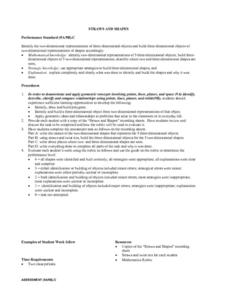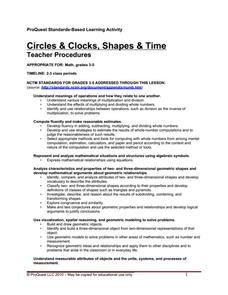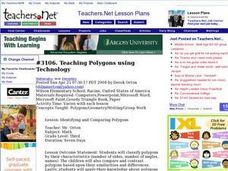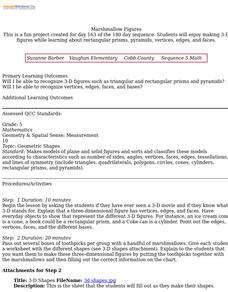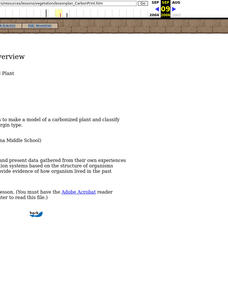Curated OER
Classifying Solids
In this geometry learning exercise, students write the name of the shape, and identify the number of vertices, edges, and faces for 6 e-dimensional shapes. Students draw 3 shapes, and classify groups of pictures.
Curated OER
"Finding Your Sweet Tooth"--An Introduction to the Dichotomous Key
Sixth graders classify candy according to observable characteristics. They use a dichotomous key to identify their bag of "treats." Thus, describe how dichotomous keys help to the identifying of organisms. Design a self-generated...
Bill of Rights Institute
Preserving the Bill of Rights
Consider how America's founding fathers and their experiences contributed to the rights we all enjoy today. A collection of reading, writing, and collaborative exercises prompt high schoolers to think about the ways their current lives...
Curated OER
Straws and Shapes
Learners investigate the concepts related to observing two dimensional objects. They also build three dimensional objects using the two dimensional objects. The students give an oral or written explanation for how the pieces fit together...
Curated OER
Circles and Clocks, Shapes and Time
Students work in groups to research clocks and practice telling time. For this telling time lesson, students use the computer program ProQuest to study circles, including radius and diameter, and practice drawing circles using a compass....
Curated OER
Polygon People
Students identify polygons. For this polygon people lesson, students draw required shapes and construct a polygon person. They identify each shape and its characteristics. The lesson may be extended by allowing students...
Curated OER
Bugs
This is not just a worksheet, but an entire set of activities and worksheets that can accompany any unit on bugs or insects. Little learners will hone early math and literacy skills as they create mini-books, discriminate between big and...
Curated OER
Teaching Polygons using Technology
Third graders utilize different types of computer programs, such as Microsoft paint and Microsoft Word to study and create different types of polygons. They use PowerPoint to create a story about a shape and others that it meets during a...
Curated OER
Right Triangles
Learners classify triangles and make connections regarding angle measurements and attributes of acute, right, and obtuse triangles. They listen to teacher define and explain triangles. Everyone imagines a place where a broken wing for a...
K-5 Math Teaching Resources
Dot Paper
In need of some dot paper for your next geometry lesson? Then look no further. This simple template allows you to maintain a classroom supply of this special paper for whenever the need arises.
Shodor Education Foundation
An Introduction To Quadrilaterals
Young geometers investigate and apply properties of quadrilaterals. After a review and discussion of key terms, students use a computer applet to explore four-sided figures and classify them according to their attributes. The...
K-5 Math Teaching Resources
Triangle Pack
With so many different types of triangles, it can be a challenge for young mathematicians to keep them all straight. Luckily this set of printable triangles is here to engage children in comparing and sorting triangles by their...
Curated OER
Identify Polygons: Algebra/Geometry Institute
Eighth graders classify geometric figures. In this polygon lesson, 8th graders identify given geometric figures. They compare and contrast different polygons. Students name line segments, identify parallel lines, and...
Curated OER
New Kids on the Block
Second graders identify and describe in their own language, the following 2-dimensional and 3-dimensional shapes: triangle, square, oblong (non-square rectangle), circle, oval, pentagon, hexagon, diamond, box, cylinder, and sphere. They...
Curated OER
Classify and Identify Polygons
In this polygon activity, students observe pictures of polygons and identify their proper name. They read descriptions of polygons and determine the polygon described. This one-page activity contains ten problems.
Savvas Learning
Colorful Triangles
Learners examine a figure made up of different types of triangles and then determine whether each triangle is right, acute, or obtuse. Next, they color each type of triangle a different color. Finally, pupils answer three fill in the...
Ohio Department of Education
Describing and Creating Plane Figures - Grade One
Young mathematicians draw, create, and describe different shapes using triangles. They discuss attributes of the original and created shapes. Pupils classify the created shapes and draw and write in mathematics journals to communicate...
Curated OER
Seeds in Fall...Collect Them All!
Classify seeds by attributes such as size, shape and color! Learners classify seeds using a dichotomous key. They identify human behaviors that have a positive impact on preserving seed and plant biodiversity.
New South Wales Department of Education
Plant Features
Pine needles are actually modified leaves. In the 16th installment of 20, young scientists explore plants. Through an analysis of leaves — shape, veins, and edges — pupils see how to classify plants based on structural features.
Curated OER
Exploring Geometric Figures
Tenth graders explore mathematics by participating in hands-on daily activities. Learners identify a list of different shapes and classify them by shape, size, sides and vertices. They utilize tangrams and geometric pieces to gain...
Curated OER
Countries Involved in World War II
Students create their own floor map of Europe, Northern Africa, and the Pacific. They locate, identify, and speak for one of the countries involved. In addition, they classify the country they represent as an Axis Power or as an Allied...
Curated OER
Marshmallow Figures
Students enjoy making 3-D figures while learning about rectangular prisms, pyramids, vertices, edges, and faces. After a lecture/demo, students use marshmallows, toothpicks and a worksheet imbedded in this lesson to create 3 dimensional...
Curated OER
"Fossil" of a Carbonized Plant
Students use leaves to make model of a carbonized plant and classify leaves by shape and margin type.
Curated OER
It Counts
Young scholars classify and compare plants using specific information, observations, and numbers. In this mathematical inquiry lesson, students use plant characteristics to describe, compare, and classify them. They attempt to develop a...





